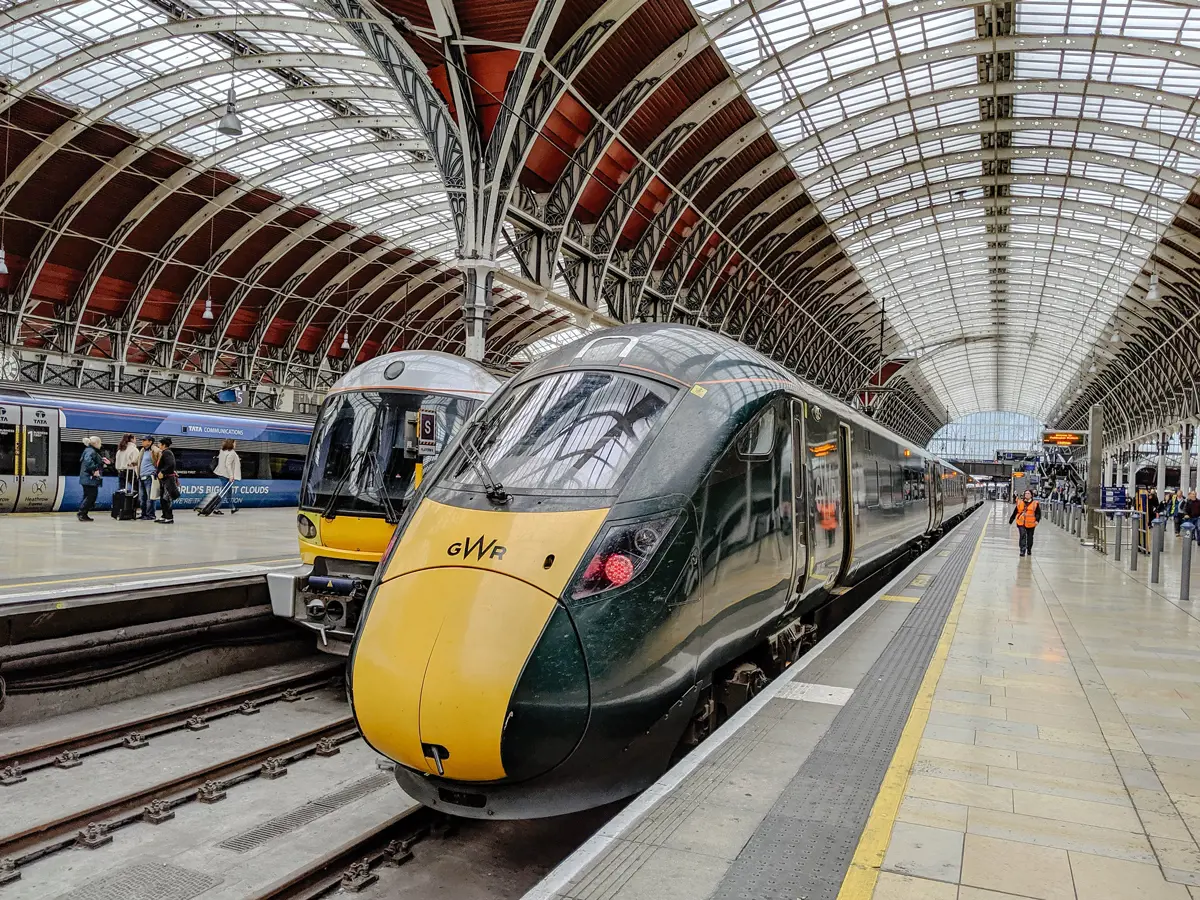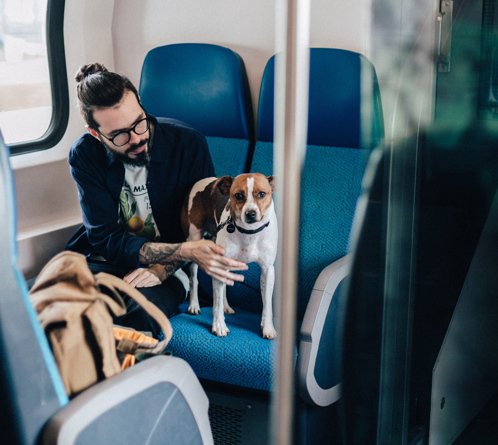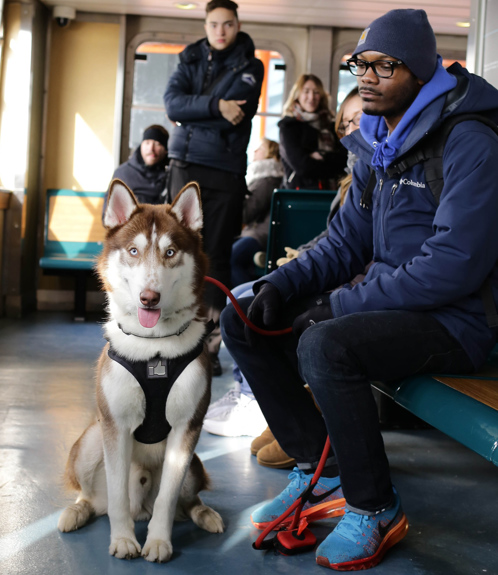How to travel with your dog on a train
27th October, 2020

Whether you’re planning an all-day outdoor adventure to one of Britain’s best beaches or a short trip to see friends, we often need to travel with our dogs. But sometimes it’s not possible or convenient to walk or drive so you’ll both need to use public transport.
One of the fastest and most efficient ways to travel is by rail, but is it possible for your dog to accompany you on the train? And how do you make the journey as stress free as possible for you, your dog and other passengers?
Having the right insurance for your dog in place before you leave home is a great place to start but what other tips and tricks are there to make it a safe and enjoyable journey?
Are dogs allowed on UK trains?
Fortunately, as you would expect for such a dog-loving nation, our train services allow dogs, cats and small animals to travel with us.
However, while all major train companies do this, it might not always be the case on every route, so it’s always worth calling ahead to check. And if your trip requires a cross-city connection then check that any buses, coaches or trams you’ll need to use also allow dogs to ride with you.
You don’t want to fall foul of any restrictions part-way through your journey.
Eurostar doesn’t allow dogs to travel with you but if you do find yourselves travelling around the continent, then there are a variety of national rules to be aware of. Trainline has a handy page that sets out the rules in each country.
If you are looking to travel abroad with your pet you should also check out the latest government advice and rules.
Many dog insurance policies also include added benefits such as cover for overseas travel. Call your insurer to find out more.

What rules apply to travelling with your pet on the train?
While dogs are allowed on most trains National Rail has set some rules that must be followed to ensure the safety and comfort of all rail travellers. These rules include:
-
Passengers can be accompanied for free by up to two dogs – if you bring more, there may be an additional charge.
-
Keep your dog on a lead throughout your journey.
-
Enclosed pet carriers or crates must be used for dogs not on a lead.
-
Any pet carrier must be rigid and not open (to prevent escape) and the dog must be able to stand and lie down in comfort.
-
Dogs are not allowed to occupy seats.
-
Even dogs in pet carriers are not allowed on seats – you can be charged for an additional occupied seat if you do so.
-
Dogs aren’t allowed in restaurant cars unless they’re assistance dogs.
-
Train companies can refuse carriage or entry to any animal (except assistance dogs) due to its size or behaviour. Be aware that if your dog is causing nuisance or inconvenience to other passengers then you could be asked to remove it from the train or railway premises.
-
Some sleeper trains, such as the Caledonian Sleeper, allow dogs on board, but you need to check ahead. A charge for heavy duty cleaning will apply. This charge is waived for assistance dogs.
Clearly there are strict rules to follow when travelling with your pup by train. If you’re travelling abroad or a great distance, then always consider investing in travel insurance to complement your dog insurance.
What to do before travelling by train
Before even considering a journey by train with your pooch, you need to give some thought to how they will react.
Are they an easy-going dog who settles easily at your feet? Or maybe they’ve travelled on public transport since they were a pup and see it as just another part of doggy life? If so, then great, you have this covered and can start planning your next adventure.
But we aren’t all so lucky. Just like people, dogs have a range of temperaments, likes and dislikes. If your dog has never travelled by train before, is nervous around strangers, or hates sudden loud noises you have to plan ahead.
Railway stations are often crowded, noisy and contain a whole range of new and interesting smells for your four-legged friend to deal with.
The key here is early socialisation and exposing your pup to as many new experiences as possible from a young age.

Training tips for train travel
Any training plan must begin with introducing your dog to the whole railway experience in relaxed manageable bursts. There’s no point in going too quick too soon.
Start off by walking them around the ticket hall to get them used to the crowds. A tasty treat or a kind word when they sit or look at ease is a great reward to positively reinforce this desired behaviour.
If you can teach your dog to follow your commands in such a busy environment it will make your travels by train a lot easier and safer.
After you’ve dealt with the hazards of the ticket hall, then start introducing them to the ticket barriers. These can be tricky so work out between yourselves how you’ll manage them (for example, who’ll go through first) with luggage and tickets in hand!
Once you feel confident at the station you can then work up to taking your first journey together. If possible, start by taking just a short train trip and closely watch how your dog reacts and build up the time on trains from there.
Depending on your dog’s temperament and what they’re used to, you might need to spend some extra time socialising them beforehand. Not just with unfamiliar people, but also with other animals, and with children.
If you’ve got any concerns, then consult your vet or a local dog trainer to see if your dog needs a bit of extra support. And if you’re considering purchasing something like a harness or a muzzle for your dog to wear during the journey, then get them used to it before you set off.
If you have a dog insurance policy from Purely Pets, then call our free 24-hour Vet Helpline at any time for advice. All calls are handled by registered veterinary nurses with a minimum of three years of practical experience.
Happy travels
A train journey with your faithful dog can be a wonderful experience but it does have its own challenges and dangers. However, follow these simple safety tips and it should go without a hitch.
-
Leave plenty of time for toilet stops before you get to the station. You don’t want them upset and uncomfortable for what could be a long trip.
-
Always clean up after your dog – if you want to be allowed back on the rail system.
-
Keep some treats handy – pairing new experiences with something nice is always a great way to reinforce calm behaviour.
-
All stations should have accessibility or mobility gates you can use to enter the station with your dog. Using these will give you invaluable time and space to get through those tricky ticket barriers.
-
When waiting on the platform, always keep well behind the yellow line. Trains sometimes appear from nowhere and at high speed, you don’t want your dog to panic and cause an accident.
-
Keep your dog on a short lead – extendable leads can be hazardous in such busy areas.
-
Obviously never allow your dog on the tracks or any other area that’s not open to travellers.
-
If you have an older dog, use lifts instead of stairs to lessen the strain on your dog and avoid causing an obstruction.
-
If you do use the stairs, then train your dog not to rush ahead of you as they might cause a danger to other stair users.
-
Never take your dog on an escalator unless you can carry them.
-
When boarding a train take particular care as there are often large gaps or awkward steps from the platform onto the train. If your dog is small and light enough then it might be best to carry them aboard, particularly at busy times of the day.
-
If your dog is deaf or blind, then consider investing in a lead or harness that will make this clear so other passengers will know to take extra special care.
-
Make sure you have water for your pup – a collapsible dog bowl is a wise investment.
-
Try to book a seat with space so that your dog can sit or lie beside you so you can comfort them if needed.
-
Even if your dog usually likes being around other furry friends, it may be wise to avoid other dogs during transport. When dogs are stressed or anxious they can behave differently from normal. Don’t take the risk.
-
Be mindful of other human passengers – not everyone is a dog lover or comfortable around dogs and some people can have allergies to animal hair.
-
Unless you know your dog is happy with receiving attention, asking people not to stroke them is probably the safest option all round.
-
Busy trains or long journeys are best avoided if your dog is fearful of strangers. It really isn’t fair to put them in that position if you don’t have to.
-
Avoid travelling during rush hour as the usual difficulties of rail travel will only be worsened.
-
If the train looks crowded then waiting for the next one might be the best option. Squeezing on board with your pet may leave them feeling overwhelmed and they may even get their paws stepped on!
Sometimes, no matter what precautions we take, accidents do happen. Having the right dog insurance in place before you travel means you’re well covered if an incident occurs.

Signs that your dog is unhappy on the train
While we are very close to our dogs sometimes it’s difficult to know what they’re really feeling. In a new situation like a train journey, it’s worth keeping an eye on your trusty friend to make sure they’re feeling as relaxed and happy as possible.
Every dog is unique but it’s important to monitor for certain behaviours so you can make a decision on what’s best for them. Sometimes you might even decide to remove them from the carriage, or even the train, if the behaviour persists or increases.
Look out for:
-
Excessive panting
-
Pacing
-
Tucking their tail between their legs
-
Barking and other vocalisation
-
Lip licking and excessive yawning
-
Ears folded back
-
Whites of the eyes showing excessively
-
Raising their paws
-
Chewing the lead
-
Excessive sniffing or scratching could be a sign that they’re trying to distract themselves.
Travel sickness
Just like humans, many dogs make good travellers while others can get anxious and sick on a journey, even a short one of just a few stops. Look out for signs such as excessive drooling, panting and swallowing, restlessness and trembling, retching or vomiting. Travel sickness is something you don’t want to have to deal with on a busy, hot train.
Travelling in the heat
Unfortunately, busy trains particularly in the warmer months, can become very hot and uncomfortable – especially if there’s no air conditioning or it’s broken. Dogs can quickly become overheated and this can be exacerbated by stress and anxiety, so monitor them carefully.
Dog insurance from Purely Pets
Heading off on a train trip can open up a whole world of adventure for you and your excitable pup. However, whether on a leisurely stroll by your side or bounding after sticks, sometimes an unexpected accident can happen.
Whether a minor or a serious injury, veterinary treatment can get expensive. Having insurance cover in place is a great way to protect yourself from this financial worry.
We’ve designed 15 levels of lifetime cover including cover for vets’ fees ranging from £1,000 to £15,000.
As well as our award-winning policies and 24-Hour Vet Helpline, you also have round-the-clock access to an online policy management portal so you can manage your cover when it suits you.
Finding a policy that will suit your budget and requirements couldn’t be simpler. Get a quote for dog insurance from Purely Pets today.
Policy benefits, features and discounts offered may very between insurance schemes or cover selected and are subject to underwriting criteria. Information contained within this article is accurate at the time of publishing but may be subject to change.
Helpful Pages
Recent Posts
Pet Insurance Quote
- 98% claims paid *
- Claims paid directly to vets
- 24/7 vet video consultations
- Interest free monthly payments




